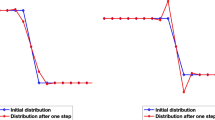Abstract
In various applications one faces the problem of estimating a signal from discontinuous observations. For example, in biomedical applications the signal may be the ‘state’ of a given organ and one observes through an external counter the amount of radioactivity sequestered by the organ after injection of a radioactive tracer. Here the problem is studied in the context of nonlinear filtering when the signal can be modelled as either a random variable or a diffusion process, and the observations have a continuous and a purely discontinuous component; both components may be affected by the signal. When the signal is a random variable an explicitly computable solution is obtained; for the diffusion case the solution is given as a sequence of approximating filters that can be computed recursively.
Similar content being viewed by others
Literature
Åström, K. J. and P. Eykhoff. 1971. “System Identification—a Survey.”Automatica 7, 123–162.
Brémaud, P. 1976. “Prédiction, Filtrage et détection pour une Observation Mixte par la Méthode de la Probabilité de Référence.” Thèse Doctorat, U. Paris VI.
— and J. Jacod. 1977. “Processus Ponctuels et Martingales: Résultats Récents sur la Modélisation et le Filtrage.”Adv. appl. Prob. 9, 362–416.
Di Masi, G. B. and W. J. Runggaldier. 1981a. “Continuous-time Approximations for the Nonlinear Filtering Problem.”Appl. Math. Opt. 7 233–245.
— and —. 1981b. “An Approximation to Optimal Nonlinear Filtering with Discontinuous Observations.” InStochastic Systems: The Mathematics of Filtering and Identification and Applications, Ed. M. Hazewinkel and J. C. Willems, pp. 583–590. Dordrecht: Reidel.
Girsanov, I. V. 1960. “On Transforming a Certain Class of Stochastic Processes by Absolutely Continuous Substitution of Measures.”Theory Prob. Appl. 5, 285–301.
Kushner, H. J. 1977.Probability Methods for Approximations in Stochastic Control and for Elliptic Equations. New York: Academic Press.
— and G. B. Di Masi. 1978. “Approximations for Functionals and Optimal Control Problems on Jump Diffusion Processes.”J. math. Analysis Appl. 63, 772–800.
Liptser, R. S. and A. N. Shiryayev 1977.Statistics of Random Processes I. New York: Springer-Verlag.
Pardoux, E. 1979. “Filtering of a Diffusion Process with Poisson-type Observation.” InLecture Notes in Contr. and Inf. Sci. 16. Stochastic Control Theory and Stochastic Differential Systems, Ed. M. Kohlmann and W. Vogel, pp. 510–518. Berlin: Springer-Verlag.
Vaca, M. V. and D. L. Snyder. 1976. “Estimation and Decision for Observations Derived from Martingales: Part I, Representations”IEEE Trans. Inf. T. IT22, 691–707.
Wong, E. 1971.Stochastic Processes in Information and Dynamical Systems. New York: McGraw-Hill.
Zakai M. 1969. “On Optimal Filtering of Diffusion Processes.”Z. Wahrscheinlichkeitstheorie verw. Gebeite 11, 230–243.
Author information
Authors and Affiliations
Rights and permissions
About this article
Cite this article
Di Masi, G.B., Runggaldier, W.J. Non-linear filtering with discontinuous observations and applications to life sciences. Bltn Mathcal Biology 45, 571–577 (1983). https://doi.org/10.1007/BF02459588
Issue Date:
DOI: https://doi.org/10.1007/BF02459588




